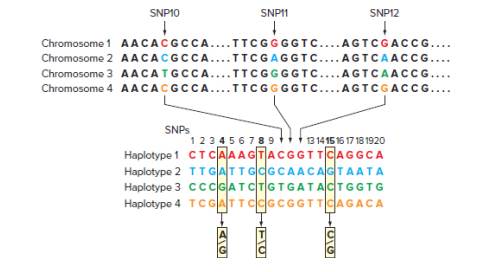
Concept explainers
In GWAS analysis, because of the existence of LD blocks (or haplotype blocks), it is not necessary to genotype a person for every one of the 50 million known SNPs. Haplotype blocks are stretches of DNA containing particular SNP variants that tend to be inherited together (as a block) because recombination within the region is rare. In the accompanying figure, three different SNP loci are shown at top (SNP10, SNP11, and SNP12), each with two alleles among the world’s population of humans.

Only four of all the possible combinations of these SNP alleles are found in human genomes, as shown in the four chromosome types pictured. These three SNPs are part of a larger block of 20 SNPs that are usually inherited in one of the four configurations, or haplotypes, shown. Because these 20 SNPs are inherited as haplotype blocks, genotyping any individual for the three so-called Tag SNPs (SNP4, SNP8, and SNP15 shown in bold) should be sufficient to predict that individual’s alleles for the other 17 SNPs.
| a. | How many configurations of the three SNPs shown at the top of the diagram (SNPs 10, 11, and 12) are theoretically possible? |
| b. | How many haplotype variants are theoretically possible considering all 20 SNPs in the haplotype block, and assuming that each of them has two possible alleles? |
| c. | Given that humans are diploid, every individual has two copies of every (autosomal) haplotype block, one on each homolog. Does heterozygosity for the haplotype blocks interfere with genotyping individuals using the Tag SNPs shown in the diagram? Explain? |
| d. | In part (c), you saw that the three Tag SNPs shown in the diagram are sufficient to type any individual for this particular haplotype block. Is this the only set of three Tag SNPs that could be used? |
Want to see the full answer?
Check out a sample textbook solution
Chapter 22 Solutions
EBK GENETICS: FROM GENES TO GENOMES
Additional Science Textbook Solutions
Biological Science (6th Edition)
Genetics: From Genes to Genomes
Applications and Investigations in Earth Science (9th Edition)
Campbell Essential Biology (7th Edition)
HUMAN ANATOMY
Biology: Life on Earth with Physiology (11th Edition)
- 10. Your instructor will give you 2 amino acids during the activity session (video 2-7. A. First color all the polar and non-polar covalent bonds in the R groups of your 2 amino acids using the same colors as in #7. Do not color the bonds in the backbone of each amino acid. B. Next, color where all the hydrogen bonds, hydrophobic interactions and ionic bonds could occur in the R group of each amino acid. Use the same colors as in #7. Do not color the bonds in the backbone of each amino acid. C. Position the two amino acids on the page below in an orientation where the two R groups could bond together. Once you are satisfied, staple or tape the amino acids in place and label the bond that you formed between the two R groups. - Polar covalent Bond - Red - Non polar Covalent boND- yellow - Ionic BonD - PINK Hydrogen Bonn - Purple Hydrophobic interaction-green O=C-N H I. H HO H =O CH2 C-C-N HICK H HO H CH2 OH H₂N C = Oarrow_forwardFind the dental formula and enter it in the following format: I3/3 C1/1 P4/4 M2/3 = 42 (this is not the correct number, just the correct format) Please be aware: the upper jaw is intact (all teeth are present). The bottom jaw/mandible is not intact. The front teeth should include 6 total rectangular teeth (3 on each side) and 2 total large triangular teeth (1 on each side).arrow_forward12. Calculate the area of a circle which has a radius of 1200 μm. Give your answer in mm² in scientific notation with the correct number of significant figures.arrow_forward
- Describe the image quality of the B.megaterium at 1000X before adding oil? What does adding oil do to the quality of the image?arrow_forwardWhich of the follwowing cells from this lab do you expect to have a nucleus and why or why not? Ceratium, Bacillus megaterium and Cheek epithelial cells?arrow_forward14. If you determine there to be debris on your ocular lens, explain what is the best way to clean it off without damaging the lens?arrow_forward
- 11. Write a simple formula for converting mm to μm when the number of mm's is known. Use the variable X to represent the number of mm's in your formula.arrow_forward13. When a smear containing cells is dried, the cells shrink due to the loss of water. What technique could you use to visualize and measure living cells without heat-fixing them? Hint: you did this technique in part I.arrow_forward10. Write a simple formula for converting μm to mm when the number of μm's are known. Use the variable X to represent the number of um's in your formula.arrow_forward
- 8. How many μm² is in one cm²; express the result in scientific notation. Show your calculations. 1 cm = 10 mm; 1 mm = 1000 μmarrow_forwardFind the dental formula and enter it in the following format: I3/3 C1/1 P4/4 M2/3 = 42 (this is not the correct number, just the correct format) Please be aware: the upper jaw is intact (all teeth are present). The bottom jaw/mandible is not intact. The front teeth should include 6 total rectangular teeth (3 on each side) and 2 total large triangular teeth (1 on each side).arrow_forwardAnswer iarrow_forward
 Human Heredity: Principles and Issues (MindTap Co...BiologyISBN:9781305251052Author:Michael CummingsPublisher:Cengage Learning
Human Heredity: Principles and Issues (MindTap Co...BiologyISBN:9781305251052Author:Michael CummingsPublisher:Cengage Learning Biology: The Dynamic Science (MindTap Course List)BiologyISBN:9781305389892Author:Peter J. Russell, Paul E. Hertz, Beverly McMillanPublisher:Cengage LearningCase Studies In Health Information ManagementBiologyISBN:9781337676908Author:SCHNERINGPublisher:Cengage
Biology: The Dynamic Science (MindTap Course List)BiologyISBN:9781305389892Author:Peter J. Russell, Paul E. Hertz, Beverly McMillanPublisher:Cengage LearningCase Studies In Health Information ManagementBiologyISBN:9781337676908Author:SCHNERINGPublisher:Cengage
 Concepts of BiologyBiologyISBN:9781938168116Author:Samantha Fowler, Rebecca Roush, James WisePublisher:OpenStax College
Concepts of BiologyBiologyISBN:9781938168116Author:Samantha Fowler, Rebecca Roush, James WisePublisher:OpenStax College





